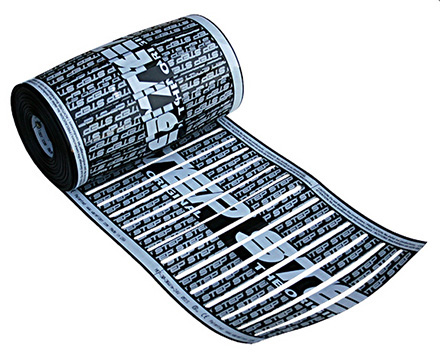Keeping roofs well maintained and free of ice dams during the winter is crucial for the longevity of both residential and commercial structures. Preventing ice dams and keeping roof edges and gutters clear of heavy snow and ice can also play an important role in enhancing safety for pedestrian traffic. When roof ice is neglected, icicles can break free and tumble onto unsuspecting people below, as well as drip and cause thin sheets of black ice to develop on sidewalks. Needless to say, this can be particularly problematic for business owners as they struggle to keep their commercial properties safe and profitable during the cold winter months.
While many roof de-icing options are available for residential and commercial applications, one in particular has distinguished itself from the others. The low-voltage RoofHeat™ STEP® system features a unique semi-conductive polymer heating element. The thin, flexible panels can be installed discreetly under shingles as well as metal roofs. The system operates on low voltage, and does not require a ground fault switch. The RoofHeat STEP de-icing roof heating system provides remarkable performance and efficiency, and has established itself as one of the most trusted and comprehensive roof de-icing solutions available. The system’s performance and ease of installation have made it a favorite among roofing professionals.
These systems are especially effective in controlling and eliminating ice dams. Ice dams form as a result of warm air escaping from the home into the attic, causing the bottom layer of snow on the roof to melt. The water trickles down to the roof eaves, but because there is no warm attic under the eaves, the water refreezes near the roof’s edge. Over time, more and more water runs down to the eave and freezes, causing a ridge of ice to form. Eventually, the ice dam causes the melted snow to collect behind it, resulting in pools of water on the roof eaves. The water in these pools can seep into tiny cracks and imperfections in the roof, causing more imperfections as it expands during the refreezing process.
About the System
The low-voltage roof de-icing solution utilizes a transformer to power the system. The transformer steps down high voltage to low voltage (60 V or less), and monitors the power and output of the self-regulating heating element to ensure safe, optimal performance.

The heating element (just 3/64-inch thick) features an impermeable membrane that is polypropylene fused during fabrication to achieve water proofing and protection from alkaline or salt damage. It is available in widths of 3, 6, 9 or 12-inches, making this system versatile enough to be installed to heat large areas, roof valleys, intricate trouble spots, and even in roof gutters.
RoofHeat STEP lightweight panels are easy to install and can be cut to size on the job site. During installation, the heating element can also be nailed or stapled through, making installation quicker and easier than other traditional roof heating systems. Additionally, the roof heating system is self-regulating, which means that when the ambient temperature rises, the electrical resistance increases and the consumption of electricity decreases, preventing the element from overheating, and ensuring energy-efficient operation.
Some basic features and benefits of the self-regulating, low-voltage roof de-icing system include:
- Proven performance
- Low-voltage
- Self-regulating
- Thin: 3/64-inch (1.2 mm) thick
- Lightweight: 0.23 lb per foot (0.34 kg/m)
- Operates quietly and efficiently
- Versatile: Works under asphalt, shake, and tile shingles, and metal roofs. The system can be installed to heat roof eaves, valleys, gutters, or even the entire roof.
- The heating element can be nailed or stapled through (Avoid nailing through the bus braids.)
- Discreet: The heating element is installed under the roofing.
- Construction: Rugged positive temperature coefficient (PTC) semi-conductive polymer with an impermeable membrane outer coating that is polypropylene fused
- 10-year limited warranty against manufacturing defects
- ETL (NRTL) listed
Low-voltage RoofHeat STEP systems are typically controlled by the STEP Touch Thermostat (activation device). The thermostat is designed for simple two-control functionality for ease of operation and features a 3-digit, auto-dim LED display. The versatile Touch sensor controls are maintenance free and capable of working seamlessly with all Warmzone radiant heat systems, and can interface with smart home systems as well. All settings are stored in permanent memory for instant recovery in the event of a power failure (no batteries are needed).
While the STEP Touch Thermostat is the recommended activation device for the low-voltage de-icing system, it can also utilize Warmzone’s advanced aerial-mount activation device. A variety of options exist, so talk with one of our radiant heat experts and we’ll be happy to help determine the best configuration and controls for your system.
Warmzone custom designs each roof heating system to best meet the needs of each customer. Professional roof heating system designers will work closely with you to ensure that you receive the best roof de-icing solution possible.
In addition to professional system design and layout services, Warmzone also includes free installation training for installers as well as technical support during the installation. We are available to your installer to assist if there are any questions during the installation. Our goal is not only to ensure that you receive the best system, but that your system is installed correctly and performing as advertised.
For more details about Warmzone’s industry-leading roof de-icing solutions, call Warmzone and speak to a customer service professional today at 888-488-9276.
